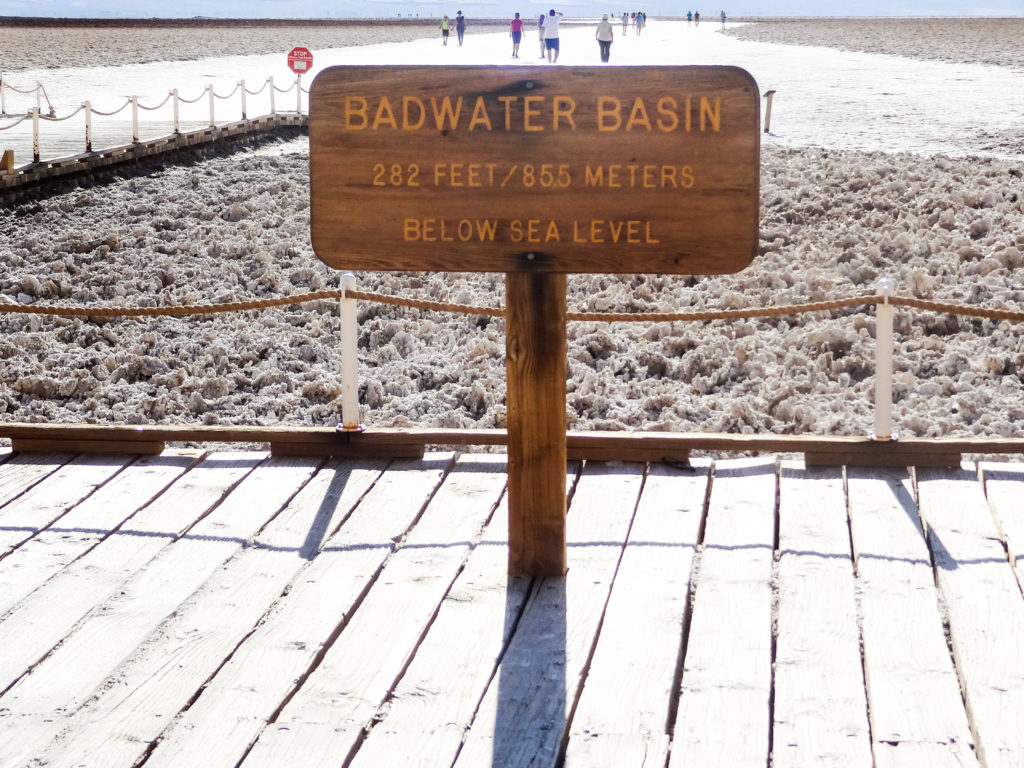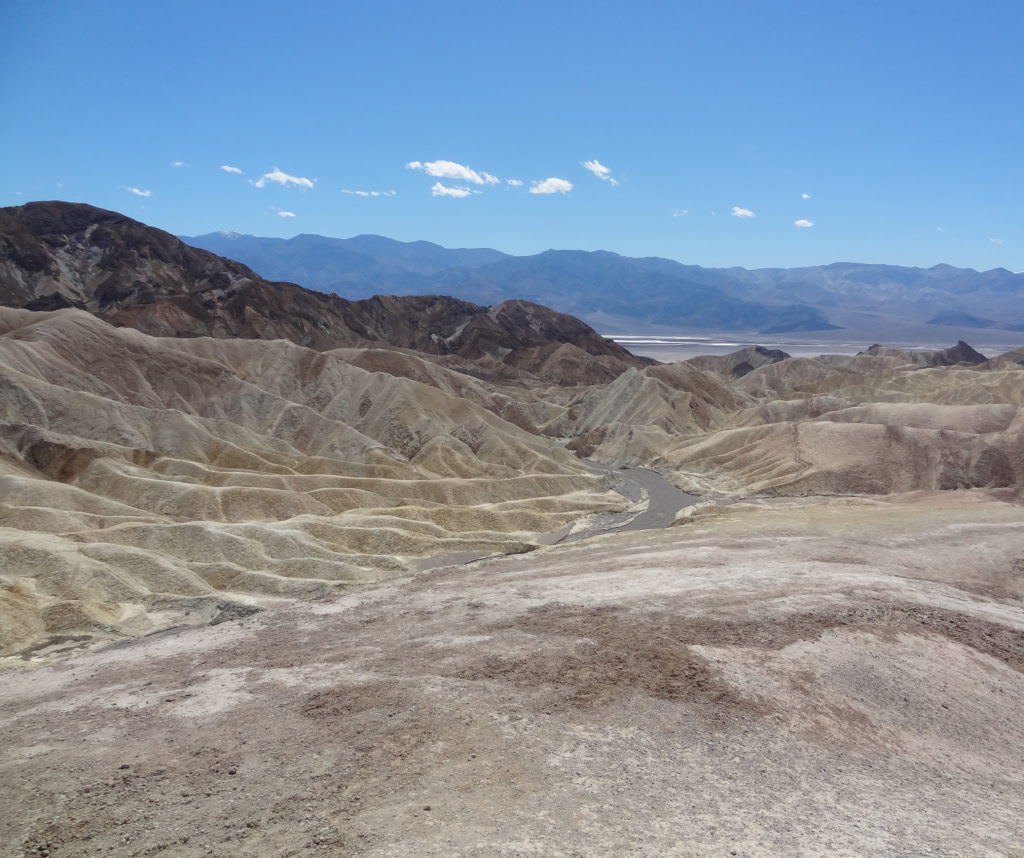Visiting Death Valley National Park is a bucket list item for many travelers. After all, it is the lowest, hottest and driest place on the North American Continent. Any place with that many superlatives is worth some thought! Here are 7 things to do in Death Valley in one day – all within a 30 minute drive of the Furnace Creek Visitor Center!



#1 Take a Picture at the Death Valley National Park Sign
Taking a picture at the entrance signs of National Parks is one way that we commemorate our park experiences. When we arrived (via I-190 from Las Vegas), there was ample space to pull off on the side of the road. This sign is unique – it has a different look and feel than many of the wooden signs that we have encountered at the National Park entrances. It’s cooler colors were reminiscent of a sunset landscape photo.
At the bottom of the sign, you will also see that Death Valley National Park is the homeland of the Timbisha Shoshone people.



#2 Visit the Furnace Creek Visitor Center
Take a break from the heat at the Furnace Creek Visitor Center. Make a note of the temperature as you pass by the digital thermometer into the air conditioned building.
In the Visitor Center, you will find great informational resources and maps to make your visit spectacular! The park has also developed great resources on things to do in Death Valley to fill any trip duration. You will also be able to watch one (or all) of the parks many videos highlighting the stories of Death Valley and its significance.



#3 Climb a Dune at Mesquite Flat Sand Dunes
Located about a 25 minute drive north of the Furnace Creek Visitor Center, you will find one of the most beautiful desert landscapes: sand dunes! Named for the Mesquite trees that provide habitat for wildlife in this sandy area, the Mesquite Flat Sand Dunes are some of the best known in the park and also some of the easiest to access.
When you arrive, you can park in the parking area adjacent to the dunes. You are able to walk into the dunes to your hearts content. The area covered in sand is deceptively large. Because you can see the perimeter of the area as you approach it by car, it may not seem like it’s as large as it is. As you get into it, you may find that climbing the dunes is more difficult than it may seem!
The parks website indicates that this highest dune found here is 100 feet.
As with other areas in the park, make sure that you take lots of water with you. Even though you can park right next to the dunes, traversing the distance in sand requires a bit of work!



#4 See the Double Wagon at Harmony Borax Works
The Harmony Borax Works is located between the Furnace Creek Visitor Center and the Mesquite Flat Sand Dunes. It is a pull off set back from the main road north of the Visitor Center. Once again, there is parking adjacent to the site.
Death Valley was once a place to mine borax, a white compound composed of mineral and salt used in detergents, cosmetics and other manufactured products (like fiberglass). In fact, Death Valley is commonly associated with 20 mule teams that pulled wagons of borax across the Death Valley desert. As you might imagine, these journeys were taxing on the humans and animals involved.
At the Harmony Borax Works, you can see one of only two wagons that were used to haul the borax from Death Valley to Mojave via a 20 mule team. It is now on the National Registrar of Historic Places.



#5 Walk at the Lowest Elevation in North America at Badwater Basin
Badwater Basin is one of the must see sites at the park, and for good reason. It is the lowest point in North America at 282 feet below sea level. This means that a visit here is HOT! Recommendations to visit this site (and the park in general) during the earlier hours of the morning are evident when you experience the suffocating heat of a midday visit.
Nevertheless, anyone exploring Death Valley in one day should make sure to pay a visit to this site where you will be able to see expansive swaths of parched land covered in salt.



One of the interpretive signs at the park indicated that the salt flats of Badwater Basin are constantly changing. Ultimately, salt crystals expand which push the crusts of salt into the look and feel of rough and rugged land through mud cracks. Then, rainstorms wash off windblown dust and generate fresh layers of white salt.
Because Badwater Basin is the lowest elevation in North America, when there are rain and flood events, water rushes to this area carrying with it minerals and salt from higher elevations. As the water evaporates, the minerals concentrate until only the salt remains. Over time, salts have accumulated and have expressed themselves as a crust over the land.
It truly is a beautiful landscape.



#6 Artists Drive
Of all of the things to do in Death Valley National Park, Artist’s Drive was my personal favorite. I really enjoy scenic drives, and the Artists Drive is a low-stress way to see the beautiful desert landscape.
The Artists Drive is accessible on the way to Badwater Basin from the Furnace Creek Visitor Center.
This drive is a moderately flat, one-lane road that was very well paved and clear. We didn’t experience any congestion along the way. Instead, we were able to take our time and enjoy the beautiful colors expressing the minerals in the rocks.
In my opinion, these rocks look like ice cream. The dark chocolate hills flow effortlessly into caramel-colored ripples. In the artist’s palate pull off itself, I observed as mint chocolate chip hues turned to raspberry chocolate chunk. I don’t think that I was seeing a mirage, but these vibrant colors really had an effect on my mind and made this drive one to remember!



#7 Zabriskie Point
When you visit Zabriskie Point, you learn about the formation of the Death Valley landscape. The badlands all around the park were actually lakes millions of years ago. Earthquakes and water worked together to create the Death Valley landscape.
Specifically, park signs indicate that the clay, sandstone and siltstone that make up the Furnace Creek Formation were formed over time as uplift, exposure and erosion carved the rocks into the landscape that is present today.
Zabriskie Point is one of the most frequently photographed sites in the park.
You can park in the parking lot which is right next to a short trail leading to an overlook. This trail is on an incline, and though short, I recommend taking water with you because it is so hot.






Conclusion – Death Valley in One Day
We hope that this is helpful to you to see that you can to a lot in Death Valley in one day!
If you would like to see how a visit to Death Valley can fit into a much larger National Park road trip from Las Vegas, check out this post.




